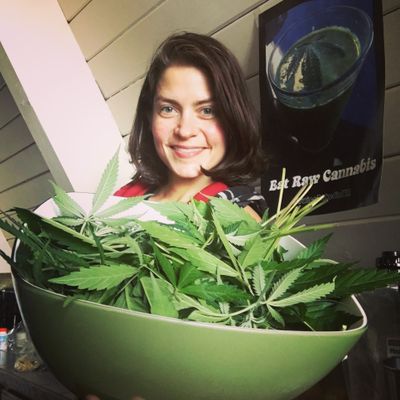Cannabis plants can have healthy properties beyond buds
Patient finds value in regular juicing

When your doctor reminds you to be sure to eat your greens, the recommendation probably doesn’t include cannabis plants. But maybe it should.
“(Cannabis) makes me feel about 10 years younger. It gives me energy, just amazing energy,” said Pam Dyer, a Spokane-area medical marijuana patient, health blogger and a founder of the Eastern Washington chapter of Women of NORML (National Organization for the Reform of Marijuana).
Since becoming a medical marijuana patient about seven years ago, Dyer has been experimenting with ways to eat the parts of the marijuana plant that don’t have psychotropic effects. This includes turning stalks and leaves into tasty smoothies.
She was initially looking for ways to relieve pain and issues related to scoliosis and other health problems.
“I was going through health coaching school,” she said. “I heard a lecture by David Wolf (an advocate for raw foodism, alternative medicine and vaccine denialism). He said, ‘If you ever get the chance to do so, eat raw cannabis. It’s the most nutritious plant in the world.’”
That sparked Dyer’s interest, so she started networking and getting to know area cannabis farmers who could provide her with leaves and stems. She also uses male cannabis plants, which are often chopped down, destroyed and composted. Female plants produce the popular and commercially-viable buds and other products.
Many growers don’t want male plants because they pollinate the female plants and take energy away from growing the resin that provides the plant’s psychotropic effect.
Initially, those industry contacts provided ample greens for Dyer to make smoothies and other concoctions with, until Washington State laws were changed that restricted how much cannabis can be personally possessed.
“It takes a lot of material to juice,” she said. “Now that all the laws have changed and there’s no home-grow, I have to get registered (as a patient) and am limited to what I can grow personally.”
Dyer has registered to grow her own plants but is still limited to only 15 (vs. four for non-registered medical marijuana patients). These limitations make it pretty much impossible for anyone but medical marijuana patients to acquire enough parts to consume regularly. The average shopper can’t currently buy their own plant stems or non-bud organic matter legally from retail stores.
Even so, Dyer wants to share her knowledge about the benefits of eating raw cannabis. A book she self-published, “Eat Raw Cannabis,” came out in mid-October and includes recipes for juicing and tips on other ways to eat the plant.
“When the plant is in the early stages the taste tends to be kind of mild, similar to a wheatgrass shot in flavor,” she said. “It’s like grass and green but very tolerable. As the plant starts to flower it gets stronger and spicier and a little harder to drink.”
When that is the case, or when she doesn’t have enough material to just juice cannabis, Dyer throws in other fruit and vegetables as filler or for extra flavoring.
“I add things like citrus that have really strong flavor. Lemons are amazing and oranges are amazing too. Cilantro and parsley really complement the taste as well.”
Dyer also uses parts of the plant to add flavor to other dishes, such as salads. She has experimented with fermenting cannabis stems and leaves, and says that the fiber the plant provides is fantastic for the digestive system.
“I definitely use the whole plant. In the normal progression of a plant’s life you’re going to take leaves off in the summer anyway and plants actually do really well when you take the leaves off. It stimulates their growth.”
Dyer says eating those leaves and other parts of the cannabis plant stimulates her mood, acts as an anti-inflammatory and relieves her chronic pain.
“After about two weeks on it, it makes me really happy. Not like I’m high but I’m in a really great mood. For my medical conditions, I don’t have migraines. I don’t have hardly any pain. I have scoliosis and the pain that goes along with chronic back pain is minimized.”
Dyer says consuming raw cannabis has also relieved a friend’s rheumatoid arthritis symptoms. While she doesn’t get high from eating the leaves and stems, Dyer does say that she has to reduce how much cannabis she ingests through other methods.
“I would have to cut those way down because they would make me super high.”
Some people have other negative reactions to eating cannabis as well.
“There are lots of different reactions to it, some people don’t do well with that deep chlorophyll and end up running to the toilet with diarrhea. I’d start with a little and ramp it up from there.”
If you decide to try juicing cannabis yourself, Dyer suggests a powerful juicer/processor to cut through stems.
“It’s ideal to have a masticating juicer or one that’s kind of slower because you want to limit the heat,” she said, as heat is known to degrade cannabis. “Or a wheat grass juicer.”
Pam Dyer’s book, “Eat Raw Cannabis,” can be purchased on Amazon.com.